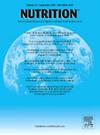术前营养状况对肺移植术后吞咽困难的影响
IF 3.2
3区 医学
Q2 NUTRITION & DIETETICS
引用次数: 0
摘要
目的本研究旨在探讨术前营养状况对肺移植术后吞咽困难严重程度的影响。方法回顾性分析。术前营养状况评估采用控制营养状况(CONUT)评分和全球营养不良领导倡议(GLIM)标准。术后第14天使用功能性口服摄入量表(FOIS)评估吞咽困难。研究变量包括年龄、性别、LTx类型、重症监护病房住院时间、机械通气使用时间、手术时间、气管造口术、体外膜氧治疗(ECMO)、肺动脉高压(PAH)、CONUT评分和GLIM标准。采用二元逻辑回归(BLR)评估独立因素。结果65例接受手术者中(女性31例,平均年龄43.4±12.0岁),术后吞咽困难(n = 39)与年龄较小相关(P <;0.001),女性(P = 0.026),双LTx (P <;0.001), ICU住院时间较长(P <;0.001),机械通气使用时间较长(P <;0.001),手术时间较长(P <;0.001),需要气管切开术(P <;0.001), ECMO的使用(P <;0.001), PAH诊断(P = 0.005), CONUT评分较高(P <;0.001)和营养不良(P = 0.031)。术前CONUT评分是唯一的独立因素(P = 0.026, OR = 0.221, 95% CI: 0.059 ~ 0.837)。结论术前营养状况对LTx患者术后吞咽功能的维持可能具有重要意义。本文章由计算机程序翻译,如有差异,请以英文原文为准。
Influence of preoperative nutritional status on postoperative dysphagia in lung transplantation
Objectives
The purpose of this study is to determine the effect of preoperative nutritional status on the severity of postoperative dysphagia in recipients undergoing lung transplantation (LTx).
Methods
A retrospective analysis was conducted. Preoperative nutritional status was assessed using the Controlling Nutritional Status (CONUT) score and the Global Leadership Initiative on Malnutrition (GLIM) criteria. Dysphagia on postoperative day 14 was evaluated using the Functional Oral Intake Scale (FOIS). Study variables included age, sex, type of LTx, duration of intensive care unit stay, duration of mechanical ventilation use, duration of surgery, tracheostomy, extracorporeal membrane oxygen therapy (ECMO), pulmonary arterial hypertension (PAH), CONUT score, and GLIM criteria. Binary logistic regression (BLR) was used to assess independent factors.
Results
Among 65 recipients (31 females, mean age 43.4 ± 12.0 years), postoperative dysphagia (n = 39) was associated with younger age (P < 0.001), female sex (P = 0.026), double LTx (P < 0.001), longer ICU stay (P < 0.001), longer mechanical ventilation use (P < 0.001), longer duration of surgery (P < 0.001), need of tracheostomy (P < 0.001), use of ECMO (P < 0.001), PAH diagnosis (P = 0.005), higher CONUT score (P < 0.001), and malnutrition by GLIM criteria (P = 0.031). Preoperative CONUT score was the only independent factor by BLR (P = 0.026, OR = 0.221, 95% CI: 0.059–0.837).
Conclusions
Our findings suggest that preoperative nutritional status may be important for the preservation of postoperative swallowing function in LTx.
求助全文
通过发布文献求助,成功后即可免费获取论文全文。
去求助
来源期刊

Nutrition
医学-营养学
CiteScore
7.80
自引率
2.30%
发文量
300
审稿时长
60 days
期刊介绍:
Nutrition has an open access mirror journal Nutrition: X, sharing the same aims and scope, editorial team, submission system and rigorous peer review.
Founded by Michael M. Meguid in the early 1980''s, Nutrition presents advances in nutrition research and science, informs its readers on new and advancing technologies and data in clinical nutrition practice, encourages the application of outcomes research and meta-analyses to problems in patient-related nutrition; and seeks to help clarify and set the research, policy and practice agenda for nutrition science to enhance human well-being in the years ahead.
 求助内容:
求助内容: 应助结果提醒方式:
应助结果提醒方式:


